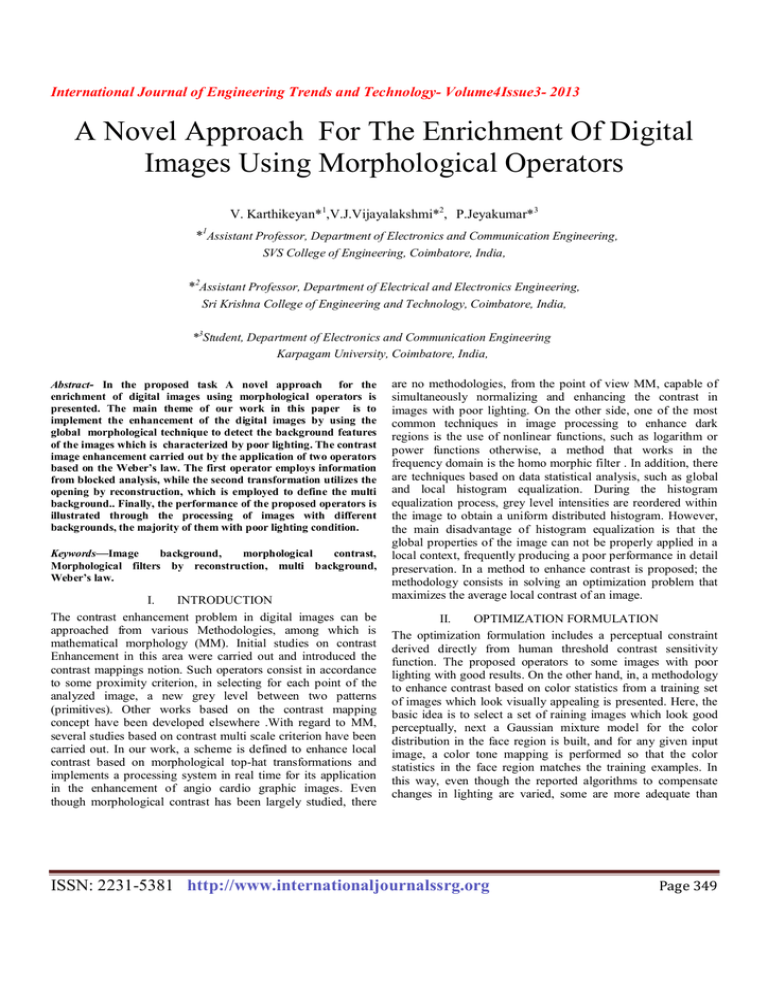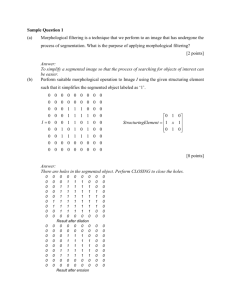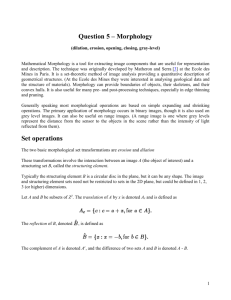A Novel Approach For The Enrichment Of Digital
advertisement

International Journal of Engineering Trends and Technology- Volume4Issue3- 2013 A Novel Approach For The Enrichment Of Digital Images Using Morphological Operators V. Karthikeyan*1,V.J.Vijayalakshmi*2, P.Jeyakumar*3 *1Assistant Professor, Department of Electronics and Communication Engineering, SVS College of Engineering, Coimbatore, India, *2Assistant Professor, Department of Electrical and Electronics Engineering, Sri Krishna College of Engineering and Technology, Coimbatore, India, *3Student, Department of Electronics and Communication Engineering Karpagam University, Coimbatore, India, Abstract- In the proposed task A novel approach for the enrichment of digital images using morphological operators is presented. The main theme of our work in this paper is to implement the enhancement of the digital images by using the global morphological technique to detect the background features of the images which is characterized by poor lighting. The contrast image enhancement carried out by the application of two operators based on the Weber’s law. The first operator employs information from blocked analysis, while the second transformation utilizes the opening by reconstruction, which is employed to define the multi background.. Finally, the performance of the proposed operators is illustrated through the processing of images with different backgrounds, the majority of them with poor lighting condition. Keywords—Image background, morphological contrast, Morphological filters by reconstruction, multi background, Weber’s law. I. INTRODUCTION The contrast enhancement problem in digital images can be approached from various Methodologies, among which is mathematical morphology (MM). Initial studies on contrast Enhancement in this area were carried out and introduced the contrast mappings notion. Such operators consist in accordance to some proximity criterion, in selecting for each point of the analyzed image, a new grey level between two patterns (primitives). Other works based on the contrast mapping concept have been developed elsewhere .With regard to MM, several studies based on contrast multi scale criterion have been carried out. In our work, a scheme is defined to enhance local contrast based on morphological top-hat transformations and implements a processing system in real time for its application in the enhancement of angio cardio graphic images. Even though morphological contrast has been largely studied, there are no methodologies, from the point of view MM, capable of simultaneously normalizing and enhancing the contrast in images with poor lighting. On the other side, one of the most common techniques in image processing to enhance dark regions is the use of nonlinear functions, such as logarithm or power functions otherwise, a method that works in the frequency domain is the homo morphic filter . In addition, there are techniques based on data statistical analysis, such as global and local histogram equalization. During the histogram equalization process, grey level intensities are reordered within the image to obtain a uniform distributed histogram. However, the main disadvantage of histogram equalization is that the global properties of the image can not be properly applied in a local context, frequently producing a poor performance in detail preservation. In a method to enhance contrast is proposed; the methodology consists in solving an optimization problem that maximizes the average local contrast of an image. II. OPTIMIZATION FORMULATION The optimization formulation includes a perceptual constraint derived directly from human threshold contrast sensitivity function. The proposed operators to some images with poor lighting with good results. On the other hand, in, a methodology to enhance contrast based on color statistics from a training set of images which look visually appealing is presented. Here, the basic idea is to select a set of raining images which look good perceptually, next a Gaussian mixture model for the color distribution in the face region is built, and for any given input image, a color tone mapping is performed so that the color statistics in the face region matches the training examples. In this way, even though the reported algorithms to compensate changes in lighting are varied, some are more adequate than ISSN: 2231-5381 http://www.internationaljournalssrg.org Page 349 International Journal of Engineering Trends and Technology- Volume4Issue3- 2013 others. Two methodologies to compute the image background are proposed. Also, some operators to enhance and normalize the contrast in grey level images with poor lighting are introduced. Contrast operators are based on the logarithm function in a similar way to Weber’s law .The use of the logarithm function avoids abrupt changes in lighting. Also, two approximations to compute the background in the processed images are proposed. The first proposal consists in an analysis by blocks, whereas in the second proposal, the opening by reconstruction is used given its following properties: a) it passes through regional minima, and b) it merges components of the image without considerably modifying other Structures. The proposals given in this paper are illustrated with several cases. The project is organized as follows. Chapter 3 presents a brief background on Weber’s law and some morphological transformations. Chapter 4 gives description about Weber’s Law and chapter 5 gives an approximation to the background by means of block analysis in conjunction with transformations that enhance images with poor lighting The multi background is introduced by means of the opening by reconstruction. III. MORPHOLOGICAL TRANSFORMATIONS In mathematical morphology, increasing and idempotent transformations are frequently used. Morphological transformation complying with these properties are known as morphological filters .The basic morphological filters are the morphological opening and closing using a given structural element. In this project, a square structuring element is employed, which represents the structuring element of size 3 ×3 pixels, which contains its origin. While is the transposed stand is a homothetic parameter. Formally, the morphological opening and closing are expressed and where the morphological erosion and the morphological dilation are respectively inf operator and is the sup operator. On the other hand, throughout the paper, we will use either size 1 or size for the structuring element. Size 1 means a square of 3 ×3 pixels, while size means a square of pixels. For example, if the structuring element is size 3, then the square will be 7× 7 pixels, to render an analysis of 49neighbouringregions. IV. OPENING AND CLOSING BY RECONSTRUCTION The reconstruction transformation is a useful concept introduced by MM. These transformations allow the elimination of undesirable regions without considerably affecting the remaining structures of the image. This characteristic arises from the way in which these transformations are built by means of geodesic transformations. The geodesic dilation ɠ1f(g)(x) and geodesic erosion Σ1f(g)║(x) of size one are given by ɠ1f(g)(x)=f(x)^ ɠ(g)(x) with g(x)≤f(x) and Σ1f(g)(x)=f(x)˅Σ(g)(x)withg(x)≥f(x) (1) respectively. When the function g(x) is equal to the erosion (dilation, respectively) of the original function, we obtain the opening ϔ µB (f)(x) (closing φµB (f)(x) respectively) by reconstruction. ϔ µB(f)(x)=limn→∞ δfn(عµB(f))(x)&φµB(f)(x)=limn→∞ عnf(δ µB(f))(x) Fig. 1 (a)original image (b)original image and the marker (c)opening by reconstruction using erosion as marker,. (d), performance of the opening and closing by reconstruction. Simillar to Weber’s law we have considered by taking the luminance L as the grey level intensity of a function (image) and the expression (5) is written as C=Klog f+b f>0 (2) On the other hand, in a methodology to compute the background parameter was proposed. The methodology consists in calculating the average between the smallest and largest regional minima, as illustrated in Fig. 4.1. Fig 2. Background detection from largest and smallest minima of image. V.IMAGE BACKGROUND APPROXIMATION BY BLOCKS The image background approximation is enhanced and the image is divided into blocks of size. Each block is a sub image of the original image. The minimum and maximum intensity values in each sub image are denoted as m i= ˄Ɯi(x) (3) Mi=˅ Ɯ i(x) (4) ISSN: 2231-5381 http://www.internationaljournalssrg.org Page 350 International Journal of Engineering Trends and Technology- Volume4Issue3- 2013 For each analyzed block, maximum and minimum values are used to determine the background criteria in the following way: Ti=mi+Mi∕2 (5) erosion defined by the order-statistical filters. A better local analysis is achieved when erosion dilation is applied instead of opening and Closing to detect the background criterion. This situation occurs, because the structuring element allows the analysis of sets of neighboring pixels at each point in the image. If size increases, more pixels will be taken into account to compute such parameter. The improved images were obtained with using equation. Notice that several characteristics not visible at first sight appear in the enhanced images. Fig .3 Background criteria obtained by block analysis The value of Ʈ irepresents a division line between clear (f >Ʈi) and dark(f ≤Ʈi) intensity levels. Once is calculated, this value is used to select the background parameter associated with the Fig .4 (a) Original Image ( b) Enhanced image after applying opening and analyzed block. As follows, an expression to enhance the closing contrast is stated as VI. IMAGE BACKGROUND DETERMINATION USING ΓTi(f) = kilog(f+1)+ Mi , f ≤ Ti kilog(f+1)+mi , (6) THE EROSION DILATION BY RECONSTRUCTION otherwise The Background parameter Ʈi depends on the value. If (f ≤Ʈi) It is desirable to obtain a function that resembles the image (dark region), the background parameter takes the value of the background without changing the original image into blocks, maximum intensity Mi within the analyzed block, and the and without using the morphological erosion and dilation, since minimum intensity mi value otherwise. Also, the unit was added these morphological transformations generate new contours when the structuring element is increased. This process is shown to the logarithm function in (10) to avoid indetermination. Since in the projected work grey level images are used, and the in Fig. 5. When morphological erosion or dilation are used with large sizes of to reveal the background, inappropriate values constant ki in (5.4) is: obtained as follows may be obtained. there is other class of transformations that Ki=255-mi*/log(256)mi*=mi, f>Ʈi allows the filtering of the image without generating new Mi, f≤ Ʈi (7 ) The above process is similar to a contrast mapping which components. modifies the intensity values depending on certain criterion. The criterion to modify the contrast in (4) is given by Ʈi. The values are used as background parameters to improve the contrast depending on the background which is different for clear and dark regions. An example to illustrate the performance of (4) considering a 1-D signal is presented in Fig. Notice that, in this figure, the intensity levels are stretched in an important way by the behavior of the logarithm function and the background parameter Mi or mi. In this way, the transformation ΓƮi (f) fulfils the next properties.The set composed by high Fig .5 (a) Original Image (b) Erosion size µ=20 contrast areas, and the set composed by low contrast areas. The composition of contrast mappings using opening closing will These process are called transformations by reconstruction. In result in lighter images for each iteration, reaching a limit our case, the opening by reconstruction is our choice because it imposed by the value of the highest level of intensity of the contact the regional minima and merges regional maxima. This image.If image is subdivided into smaller blocks each time, the characteristic allows the modification of the altitude of regional background function tends to be similar to the original function. maxima when the size of the structuring element increases. This On the other hand, given that, maximum and minimum values effect can be used to detect the background criteria in (5), are analyzed for each block, an extension using morphological operators is presented as follows. Notice that the window corresponds to the structuring element . For the sake of Ʈ(x)=ϒµ(f)(x) (8) simplicity values correspond to the morphological dilation and ISSN: 2231-5381 http://www.internationaljournalssrg.org Page 351 International Journal of Engineering Trends and Technology- Volume4Issue3- 2013 (a) (a) (b) Opening & Closing is maintained and only the way to detect the background is modified. An example of this modification is shown in Fig. 7.2. Input images are located in Fig. 6(a) where as enhanced images are presented in Fig. 6(b). The image background criteria were calculated with a structuring element size 10. On the other hand, it is possible to use the opening by reconstruction to generate the image background similarly to that presented, and not only, as a criterion to detect the background as was presented. An uneven background,which is detected from an image with important variations in lighting. Observe that the background touches only regional minima, while the other regions contain local information of the original function. From these extreme points and the local information provided by the original function and the important information about the image can be acquired. When considering the opening by reconstruction to detect the background, one further operation is necessary to detect the local information given by the original The morphological transformation in opening & Closing is maintained and only the way to detect the background is modified. An example of this modification is shown in Fig. 6. Input images are located in Fig. 6(a), whereas enhanced images are presented in Fig. 6(b). The image background criteria were calculated with a structuring element size µ=10 for all output images. TABLE.1 (b) Fig.7 Histogram for Dialation (a) Original images. (b)Enhanced images. Fig .6 Erosion by reconstruction as background criteria (a) Original images. (b)Enhanced images. The following expression derived is proposed to enhance the contrast in images with poor lighting عϒµ(f)=k(x)log(f+1)+ع1[ϒµ(f)] (11) (7.3) (10) Fig.8 Image background approximation by Erosion Dilation VII.EMPIRICAL RESULTS The Erosion dilation and opening closing Results was listed below. PERFORMANCE ANALYSIS FOR VARIOUS IMAGES PSNR & MEAN VALUES Erosion Dialation Opening Closing PSNR Mean PSNR MEAN Tumor Tower 14.9124 2.7778 37.8881 57.3989 18.3777 7.4313 110.3905 87.3987 Man 6.3124 49.5454 9.5674 70.6574 Original image ISSN: 2231-5381 http://www.internationaljournalssrg.org Page 352 International Journal of Engineering Trends and Technology- Volume4Issue3- 2013 Original image Enhanced image Fig .9 Histogram equalization 1. J. M. Zurada, R. J. Marks 11, C. J. Robinson (Eds.) Computational Intelligence Imitating Life, IEEE Press, 1994. 2. W. Pedrycz, Fuzzy Evolutionary Computation, Kluwer Academic Publisher, Boston, 1997. 3. F. Russo, "Nonlinear Filters Based on Fuzzy Models" in S. K. Mitra and G. L. Sicuranza (Eds.) Nonlinear Image Processing, Academic Press, 2000, pp.355374. 4. F. Russo, "Noise Removal from Image Data Using Recursive Neuro fuzzy Filters", IEEE Transactions on Instrumentation and measurement, April 2000, vo1.49,n.2, pp.307-3 5. D. E. Goldberg, Genetic algorithms in search, optimization & machine Adison-Wesley Publishing Company Inc, Reading, 1989. 6. F. Russo, “Recent advances in fuzzy techniques for image enhancement,”IEEE Trans. Instrum. Meas., vol. 47, pp. 1428–1434, Dec. 1998. 7. “Evolutionary neural fuzzy systems for data filtering,” in Proc.IEEE Instrumentation and Measurement Tech. Conf. (IMTC/98), St.Paul, MN, May 18–21, 1998, pp. 826–831. 8. W. Pedrycz, Fuzzy Evolutionary Computation. Boston, MA: Kluwer, 1997. 9. J. B. Bednar and T. L. Watt, “Alpha-trimmed means and their relationship to the median filters,” IEEE Trans. Acoust., Speech, Signal Processing, vol. ASSP-32, pp. 145–153, Feb. 1987. 10.Y. H. Lee and S. A. Kassam, “Generalized median filtering and related nonlinear filtering techniques,” IEEE Trans. Acoust., Speech, Signal Processing, vol. ASSP-33, pp. 672–683, June 1985. Fig.10 Background approximation VIII. CONCLUSION This paper presents a study to detect the image background and to enhance the contrast in grey level images with poor lighting. First, a methodology was introduced to compute an approximation to the background using blocks analysis. This proposal was subsequently extended using mathematical morphology operators. However, a difficulty was detected when the morphological erosion and dilation were employed; therefore, a new proposal to detect the image background was propounded, that is based on the use of morphological connected transformations. These contrast transformations are characterized by the normalization of grey level intensities; avoiding abrupt changes in illumination The performance of the proposals provided in this work were illustrated by means of several examples throughout the paper. REFERENCES: ISSN: 2231-5381 http://www.internationaljournalssrg.org Page 353



